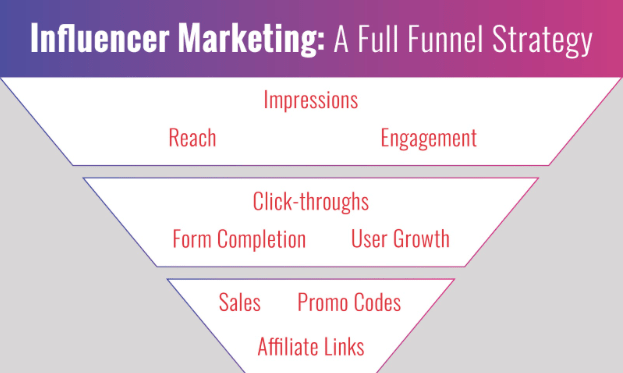Influencer marketing has different effects at every stage of the customer journey. Similarly, the selection of most important metrics changes at various areas of the funnel. To properly manage your efforts, you must look at metrics that reflect the greater customer journey.
[Infographic: Influencer Marketing and The Customer Journey]To help, we’ll define the most important influencer marketing metrics based on where your customers are on their path to making a purchase.
Top of the funnel
Reach
Audience reach is defined as the number of unique accounts that see any given post. Theoretically, you need an influencer with a huge following to potentially increase the number of people who will see your content and engage with it. Truth is, only a small proportion of those followers get to see the content. Focusing on audience reach might only be worth the investment if your brand operates in a highly targeted industry.
Impressions
Impressions are the number of times your content is displayed on a social platform. Clicks, comments, likes, and other interactions don’t factor into this metric; all that counts is if your content is visible. When it comes to influencer marketing, impressions are the most immediate form of success. It is also more accurate, as it reflects the true reach of the influencer for any given post.
Note that impressions could lose value if you don’t pick the right influencer. Analysing your target audience psychographics is crucial. Demographics (gender, age, education level) can be less important than interests and personal values.
Engagement
Engagement tracks the number of people who interact with your content, whether that’s alike, a comment or a share. In terms of influencer marketing, high engagement indicates the audience’s level of interest. Click-throughs, shares, comments, and likes are all considered engagements.
What’s great about engagements is that they can be considered a form of direct feedback. A comment might tell you exactly how an audience member feels about the product or your influencer partnership. That said, though it may seem that engagements take a backseat to impressions, the truth is that engagements are a validator of the overall quality of an impression and the given effectiveness of a post.
Middle of the funnel
Conversions
Conversions measure how many people respond to a call to action and are a greater indicator of how strongly people react to your content. These conversions can take different forms, depending on your campaign goals.
The following mid-funnel metrics can all be considered conversions:
- Deep link click-throughs: Measure this metric if your goal is to direct social content readers to a specific area on your site other than the homepage (a product page, for example).
- User growth: Tracking your follower count indicates how well your brand resonates with the influencer’s audience. Those most interested will follow your profile to receive similar content.
- Form completions: You can check the exact number of consumers who click a social media link to fill out a form on your site — for example, to sign up for an email newsletter or complete a survey. Again, this is an indicator of how well your brand and its content matches that of the influencer’s followers.
Bottom of the funnel
Promo codes
Discounts are a great way to convert viewers into buyers. Add a time limit to the sale, and the concept of scarcity will make them even more likely to buy.
Customize promotional offers for each influencer’s audience to better track each campaign.
Sales
Even if you don’t offer a promotional code, you can track sales by having the influencer link to a specific landing page (if possible, one that can’t be found any other way). You can then view the sessions sent from that link and see how many of them complete a purchase.
Understanding what metrics say about your campaign
Evaluating the success of your influencer partnership is all about knowing the benchmarks for your industry. Consider this example: a maximum speed of 30 miles per hour is fast for a human but slow for a car. The point being, it’s all relative.
In order to truly evaluate what the metrics say about your strategy, you need to know what a successful campaign looks like for your industry and then compare the data.
Campaign metrics without benchmarks are just numbers. You’ll need to analyze your results in light of the following baselines as they apply to your goals:
- Industry: What’s good for brands that are similar to yours?
- Content type: What metrics indicate a well-performing video, image or blog post?
- Platform: What’s a good impression number for Instagram? What about Facebook?
This is where Open Influence’s experience can help you, comparing the data your campaign generates to that of others to determine how well you’re doing. Brands that do influencer marketing in-house don’t have nearly as much data to compare and analyze. They can track their various campaigns against each other and other internal data, but they can’t see how well their influencer content performs compared to the general market.
Open Influence, on the other hand, has helped with thousands of influencer transactions and assisted on campaigns in every vertical. Our first-party data drives insightful reporting and analysis that accurately tells you how well your strategy performs and helps you target what needs to be optimized.
As influencer marketing evolves and brands find new ways to interact with consumers, these businesses need trusted, experienced partners to connect them to the social media stars who resonate best with their audiences. Open Influence was one of the first in the game, and our years of experience and expertise will help you create a successful influencer marketing campaign.






